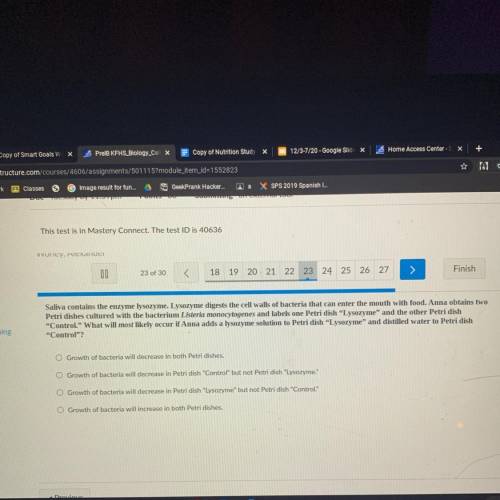
Biology, 09.12.2020 05:10 Yangster9305
Saliva contains the enzyme lysozyme. Lysozyme digests the cell walls of bacteria that can enter the mouth with food. Anna obtains two
Petri dishes cultured with the bacterium Listeria monocytogenes and labels one Petri dish “Lysozyme" and the other Petri dish
"Control.” What will most likely occur if Anna adds a lysozyme solution to Petri dish “Lysozyme" and distilled water to Petri dish
"Control"?


Answers: 3


Other questions on the subject: Biology

Biology, 22.06.2019 00:00, natalievick03
Acar company is testing seatbelts using crash test dummies. the company finds that when cars come to a sudden stop, the crash test dummies' bodies continue to move forward. the seat belt keeps the crash test dummies from hitting the back of the seat in front of them. why do the crash test dummies' bodies continue to move forward even though the car stopped? a. the friction opposing their bodies' movement keeps them in motion. b. the inertia of their bodies keeps them in motion. c. the forward acceleration of the car keeps them in motion. d. the gravity pulling on the car keeps them in motion.
Answers: 1


Biology, 22.06.2019 10:30, nonjabulomabaso7423
Subduction zones form when an oceanic plate collides with another oceanic plate or continental plate. the continental crust is lighter and less dense than oceanic crust. continental crust's density is approximately 2.7 grams per cubic centimeter. oceanic crust is thinner and the average density is about 3.3 cubic centimeters. when the two crustal plates converge the oceanic plate always bends and subducts beneath a continental plate. once the oceanic crust subjects, the rocks are subjected to changes in heat and pressure. because of this, we would expect to find rocks in the area of a subduction. a) clastic b) igneous c) metamorphic d) sedimentary
Answers: 2

Biology, 22.06.2019 17:30, claudialopez093
Aquantity of gas has a volume of 18 m3 and an absolute temperature of 225 k. when the temperature of the gas is raised to 380 k, what is the new volume of the gas? (assume that there’s no change in pressure.)
Answers: 1
You know the right answer?
Saliva contains the enzyme lysozyme. Lysozyme digests the cell walls of bacteria that can enter the...
Questions in other subjects:






Mathematics, 26.09.2019 14:30



Mathematics, 26.09.2019 14:30

Mathematics, 26.09.2019 14:30



